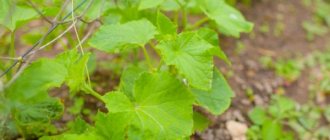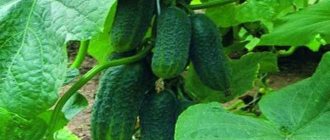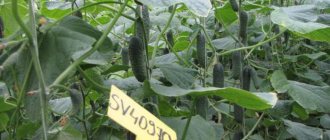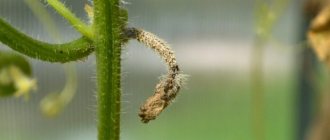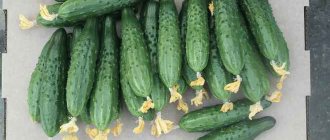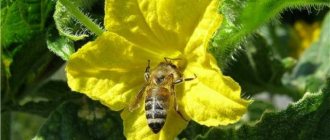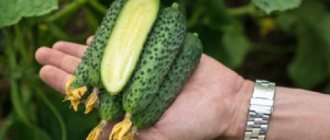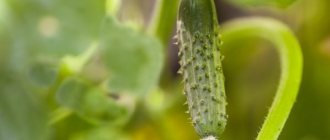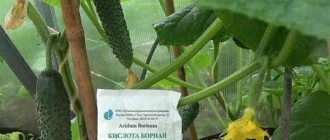Cucumber is a tasty, life-giving fruit that can be eaten both fresh and pickled. It is very good in salads and okroshka, in canned food and winter preparations, and is effectively used as a traditional medicine and as a cosmetic product.
Everyone knows that this juicy and healthy vegetable can grow in an ordinary garden and in a “warm” garden bed, in a greenhouse and even on a balcony. However, not everyone knows that cucumbers are a rather capricious garden crop that cannot easily take root in a new place and require special attention and care.
This situation exists due to the individual characteristics of the cucumber root system, the depth and location of which has a significant impact on the growth, development and fruiting of the entire crop. For example, it is not recommended to replant a vegetable, and when planting it in open ground, it is necessary to adhere to the proper requirements and conditions.
Therefore, it is very important to know what kind of root system cucumbers have in order to be able to strengthen, strengthen and improve it. This is exactly what our article will discuss.
Description of underground structure
The root system of the vegetable consists of one large root, from which lateral shoots emanate, located along a radius. The very first of them form a real web-like network, but they are located very close to the surface of the earth, which provokes their constant damage and disruption. At the same time, this structure helps the garden crop to hold onto the soil more tightly and absorb more nutrients and life-giving moisture.
What is the depth of the cucumber root system? Its height is approximately one and a half meters, which allows the vegetable to find nutrients deep in the soil.
How does the root system of cucumbers develop (photos of it are presented in the review)? Where does its formation and prosperity begin? The answer is obvious - of course, from landing.
How to loosen cucumbers
Although the roots of the plant are located close to the surface, to increase the permeability of the soil it is necessary to loosen it. After frequent watering and heavy rains, the soil becomes so compacted that moisture does not penetrate deep and nourish the cucumbers. And here it is necessary to loosen the top layers of the soil. Carry out the procedure carefully, trying not to damage the delicate roots. It is best to use a rake for this, harrowing the area around the bush.
In order for organic and mineral substances to penetrate to the roots, solutions are applied when loosening the soil according to the following scheme: first, with a tool, the soil is made permeable and loose, and then watered with fertilizers diluted in a bucket of water.
After the loosening procedure, watering will be better. Water does not leave, but easily penetrates through loose layers of soil to the root system of cucumbers. It is best to organize drip or furrow irrigation for this. The soil around the cucumber bushes will be better moistened, and the fruits will set faster.
Cucumbers should be loosened as needed, in combination with weeding the beds.
Sowing cucumber seeds
Yes, the depth of the root system of cucumbers is truly impressive. However, in order to sow these vegetables, you will need shallow peat cups that can remove themselves after a certain period of time and thereby fertilize the plant with peat minerals.
Experts do not recommend using a common box for sowing. Individual planting of seeds will help to carefully transplant the root shoots. This is due to the fact that when seedlings are directly planted in the ground, the root system of cucumbers, the size of which will already reach ten centimeters in length, is practically not affected. This procedure can be carried out just two to three weeks after germination.
Are there any additional tips for planting cucumber seedlings?
How long is the root of a cucumber and why is it important for a gardener to know this?
This is far from an idle question: why does the average summer resident need to know how the root system of cucumbers works? The health of a plant's roots determines its development and productivity. In the case of this crop, it is important to take into account all the features of its structure so that labor and other costs more than pay for themselves.
The structure of the root system of cucumbers
The main root of a cucumber is a taproot that extends into the soil. The depth of root penetration depends on the climate. For example, in the central zone it rarely exceeds 30 cm, in the south - a meter, in especially dry areas it reaches one and a half meters.
The primary feeding roots are located in the near-surface layer - at a 20–30 cm level. They extend from the main root radially along its entire length. But the deeper the rod penetrates, the fewer the number of lateral roots becomes and their length decreases.
A complex interweaving of first-order feeding roots holds the vine in the ground and also collects the necessary nutritional elements. With a strong core, the supply network is quite fragile - it breaks easily when loosened carelessly, and dies at temperatures below 13°C. A lack of moisture causes its development to stop; in return, the rod that produces water strengthens.
The high absorptive capacity of the root system, the specific weight of which is only 1.5% of the mass of an adult vine, is explained by the huge surface area of the roots - main, primary and secondary. It is several times larger than the area of leaves!
To keep cucumber roots strong
The fragility of the cucumber root system is the main reason why the plant is considered capricious. However, it is enough to follow the rules of cultivation so that the “whims” do not cause much trouble.
Sowing
Although the roots of cucumbers are quite long, seedlings need small cups for their formation and initial growth. Sowing is not carried out in a common seedling container - when picking, a large number of weak lateral roots are damaged, which not only slows down growth, but also creates an additional threat of disease development.
Summer residents often grow cucumber seedlings in common seedling containers, using steamed sawdust as a substrate. Their structure promotes the rapid development of the root system; slightly grown seedlings are planted without damaging the thin roots.
Transplanting
When carrying out preparatory activities before planting seedlings, take into account their features:
- How long is the root of a young cucumber? Usually, a three-week-old plant has a root that exceeds 10 centimeters. This is taken into account when forming the holes.
- What is the soil temperature? More often than not it is lower than the one to which the seedlings are accustomed. That is why hardening of seedlings is required.
- The size of the feeding area of each plant - the feeding roots are able to develop the soil at a distance of up to half a meter from the main stem. This factor determines the distance between the vines. To ensure correct development of the root system and sufficient supply of nutrition, maintain a distance between planting points - at least 40 cm in a row in a greenhouse, 30 cm in open ground.
The lateral roots, although weak, are “voracious” - they quickly draw nutrients from the soil. That is why only one plant is planted in one hole: if you plant even two seedlings, competition will lead to the weakness of both.
Care
Since lateral roots resist various adversities equally poorly, regardless of age, caring for borage also has its own nuances.
Loosening
The procedure is carried out extremely carefully: restoration of damaged roots occurs within a week if the soil moisture is not lower than 80%. During this period, the vine receives an insufficient amount of nutrients, that is, the summer resident harvests the crop later, and the fruits will be of poorer quality.
To avoid such troubles, cucumber beds after planting seedlings are covered with a layer of mulch.
Suitable organic material is determined by the following criteria:
- bed illumination level;
- soil moisture capacity;
- growing temperature;
- pH indicator and degree of soil salinity;
- the amount of organic matter in the substrate.
Hilling
As a rule, when growing cucumbers, hilling is rarely carried out, although this particular procedure helps to increase the volume of the root system and is especially useful for increasing the yield of early and mid-early varieties.
Typically, two methods of increasing the root mass are used for seedlings:
- Substrate is added to the seedlings in the pots as they grow. The technique is suitable for varieties that form adventitious roots. If you look closely at the stems of the seedlings, you can see small tubercles on them - future lateral roots.
- Seedlings that have produced two leaves are transferred to a higher container - milk bags, plastic bottles cut to 2/3 of the height, etc. As in the previous case, soil is added as the bush grows.
When transplanting such seedlings into beds, the holes are dug deeper than during standard cultivation.
To increase the number of roots of cucumber bushes directly in the garden bed, seedlings are planted in a trench. A plant with a lump of earth is placed in a ditch, covered with a layer of straw 8-10 cm, then with soil.
A number of varieties are capable of forming additional roots in the leaf axils. In this case, hilling is a guaranteed way to increase the yield of vines.
This feature is used when growing crops in heated greenhouses: the fruit-bearing lower part of the stem is rolled into a ring and covered with soil.
The formation of new roots stimulates further growth of the vine and its fruiting. The harvest from such plants can be harvested within 10-12 months.
Feeding
You should pay attention to the developmental features of cucumber roots when there is a lack of basic elements.
- With a lack of nitrogen, the growth of lateral processes is reduced or stopped.
- With phosphorus deficiency, the length of the roots responsible for the absorption of nutrients decreases.
The exposed roots are immediately covered with soil; in the light they stop branching. The general lack of lighting for cucumbers also inhibits the development of the feeding system.
Unusual growing methods
Summer residents, concerned about good protection of the root system of cucumbers from diseases, often invent the most unusual methods of growing the crop.
Successful experiments in growing tomatoes in buckets, suspended so that the tops face down, extended the idea to other crops - cucumbers growing upside down are successfully grown. The technique is very simple:
- Select large containers (from 5 liters), and make fairly large holes in the bottom - 3-5 cm.
- The bottom of the container is lined with two-centimeter thick foam rubber, and a nutritious soil mixture is filled in.
- The containers are hung.
- Cucumber seedlings are planted in holes punched in the bottom of the containers.
This technique is usually used when growing cucumbers at home - on a loggia or veranda.
Maintaining conditions for the normal development of the root system of cucumbers is an important component of crop care. Experienced gardeners say: “What are the roots of cucumbers, such will be the harvest.”
Source: https://goodgrunt.ru/cucumbers/kornevaya-sistema-ogurcov.html
Preparing holes for seedlings
Since the cucumber root system is large in size and volume, and also because it is very weak and fragile, it is not recommended to plant several shoots in one hole. By taking away useful microelements from each other and shielding each other from the warming sun, plants will focus all their energy on survival rather than on fruiting. This will negatively affect both their development and the quality and quantity of the harvest.
What is the optimal distance to maintain between holes? From practice it is clear that the best distance between plants (as well as between rows) should be thirty centimeters.
Cucumber nutrition area
You can already imagine what kind of roots cucumbers have. They are quite weak, but at the same time they absorb huge amounts of nutrients from the soil. Therefore, you should not plant several plants in one hole, as they will inhibit each other. Each of them will receive significantly fewer important elements, so the stems will diligently try to stretch out so as to weaken the opponent with their shadow. As a result, there will be less energy left for fruiting.
The feeding area will depend on whether the plant “lives” in open ground or a greenhouse. In the first option, two rows of cucumbers can be planted in a one-meter wide bed. The distance between them, as well as between the plants in each of them, is about 30 cm. For a greenhouse, the rules change somewhat. Here there should be about 60 cm between the rows, and the plants in each ridge are 40 cm apart from each other.
Seedling care: loosening
Caring for the cucumber root system primarily includes caring for the seedlings themselves.
These vegetables prefer soil rich in ozone, so the soil around them should be regularly loosened and fluffed up. However, this must be done carefully, since the root system of the cucumber is very close to the surface of the earth.
It is recommended to constantly inspect the soil in which vegetables are grown. If the soil becomes crusty, which may impede air exchange, then the soil must be lightly cultivated. But not too deep, so as not to damage the root processes.
Agrotechnical innovations
Not all regions have climatic conditions and soil composition suitable for this capricious crop, and the first problem is that the cucumber’s root system begins to ache and wither. The plant, accordingly, dies. Therefore, summer residents invented a new way of growing vegetables. To do this, pots of suitable volume are hung on a stand, their bottom is covered with 2-centimeter foam rubber.
The method of growing crops in film and non-heated greenhouses is widespread today. However, not all varieties of cucumbers will produce a bountiful harvest. It is necessary to purchase self-pollinating ones, otherwise they are also called parthenocapic, although it is possible to grow varieties recommended for open ground, provided that pollination is guaranteed (by regularly opening the greenhouse).
Hilling
Hilling cucumbers is not recommended. This can be done only in rare cases - when the lower stem of the plant is damaged and it dies. Then the thin shoot is rolled up and covered with a bucket of black soil, after which there is a possibility of the formation of a new, strengthened root system.
So, we have looked at practical tips on how to start growing cucumbers in your summer cottage. Are there additional recommendations regarding strengthening the root system of this crop? Let's find out.
Biological features of cucumbers
Under favorable growing conditions, cucumber seeds sprout 4-6 days after sowing; during the first growing season, the root system grows more intensively than the above-ground part of the plant. Subsequently, the growth of the aerial part increases. When seeds germinate, 2 thick fleshy cotyledons appear on the soil surface, which act as leaves, feeding all the organs of the young plant. Their importance in the life of a plant is very great: the growth and timing of the beginning of flowering of cucumbers depend on them. The first true leaf is formed only 5-6 days after germination. During its formation, flower tubercles begin to form in the axil. 8-10 days after the first leaf, the second one is formed. After the root system has developed sufficiently, rapid growth of leaves and stems begins. Each new leaf appears after 5-4 days, then after 1 day, every day, and then 2 or more leaves are formed per day. The stem also grows slowly at first, and then faster, reaching an increase of up to 2 cm per day, after the formation of 4-6 leaves in early-ripening varieties, and 6-8 in late-ripening varieties, shoots of the first order develop from the axils of the leaves of the main stem. In the axils of the leaves of shoots of the first order, shoots of the second order are formed, etc.
After fertilization under normal growing conditions, the cucumber ovaries grow quickly, and the fruits reach technical (removable) maturity within 7 - 12 days after fertilization (green phase).
Relation to temperature conditions. Cucumber is one of the most heat-loving crops. Seeds begin to germinate only at a soil temperature of 15-18 ° C (hardened seeds can germinate at 10-13 ° C). At lower temperatures, the seed coat and its contents swell and rot, which is often observed during early sowing. For seed germination, the optimal temperature must be maintained daily for at least 5-6 hours. The higher the temperature, the faster and more friendly the seedlings appear. When sown in soil heated to 20 °C, seedlings appear after 5 days, at 18 °C - after 10.
At temperatures below 13-15 °C, plant development stops, the absorption of nutrients and water by the roots is weakened, favorable conditions are created for the spread of root rot, powdery mildew and other diseases, and female flowers fall off. A prolonged decrease in temperature to 8-10 °C or exposure to temperatures of 3-4 °C for 3-4 days can lead to plant death. At a temperature of 6 °C the leaves turn yellow. Seedlings and adult plants do not tolerate frost. Cucumber plants tolerate low temperatures after germination more easily than low temperatures during germination.
Cucumber is especially sensitive to temperature conditions during the formation of reproductive organs. A decrease in temperature below 16 C and an increase above 25 ° C during the flowering period has a depressing effect on the growth of pollen tubes - the pollen becomes sterile, fertilization stops. The optimal temperature for flowering and fertilization of flowers is 18-21 °C.
At optimal temperatures (22-25°C), flowering begins, depending on the variety, on the 22-28th day after emergence, and the formation of green foliage begins on the 32-38th. At a daytime temperature of 17-19 °C and a night temperature of 12-14 °C, early-ripening varieties begin to bear fruit only after 40-50 days, mid-ripening varieties - after 45-55, late-ripening - 55-65 days after emergence.
Prolonged cold and wet weather damages the plant to a greater extent than prolonged drought. Cold snaps at night in summer and early autumn shorten the growing season of cucumbers. With sharp temperature fluctuations, they experience a lag in growth, first of all, the roots die off. At elevated temperatures, plant growth stops at 42 °C.
Cucumber fruits grow mainly at night, when organic matter breaks down and its products flow into the fruit. The greenery grows most intensively at temperatures of 20-25 °C during the day and 18-20 °C at night; at lower temperatures, fruiting stops.
The sum of effective air temperatures required for the growth and development of cucumbers, from sowing to the start of harvesting, is 1172-1198 °C. Currently, a number of cold-resistant varieties have been developed, but they are still most productive in warm, humid climates.
Attitude to moisture. Cucumber places increased demands on soil and air humidity; for seed swelling, 36-42% of water from its absolutely dry mass is needed, and for germination - 20-25% more. Cucumber plants have a relatively weakly protected leaf surface from evaporation, so to form 1 g of dry mass, it evaporates 500-800 g of water. In addition, the cucumber root system has a low suction force (1.5-2 atm), and therefore it is sensitive to a lack of moisture not only in the soil, but also in the air. Even with favorable soil moisture, but with very dry air, plants reduce their yield.
Cucumber plants stop growing if soil moisture drops to 10.1% of HC (lowest water holding capacity). With insufficient soil moisture and low relative air humidity, cucumber plants grow poorly, develop slowly, the first ovaries fall off, and the yield and its quality decrease. At the same time, excess soil moisture exceeding 85% of the total moisture capacity, combined with low temperature, leads to the death of the root system.
The optimal soil moisture for cucumber is 75-95% HB, and the relative air humidity is 70-80%. Plants need higher soil moisture in the first period of the growing season - before flowering. The plant consumes the greatest amount of water during the period of intensive fruiting, when the plant can use more than 5 liters per day. Therefore, cucumber is sensitive to drought, especially during flowering and fruiting periods.
A decrease in air humidity in greenhouses to 50% causes leaves to wilt, which reduces the assimilation of carbon dioxide by 40-50% at the initial signs of wilting and by 70-80% in plants with drooping leaves. In wilted leaves, the loss of plastic substances through respiration exceeds the gain from assimilation by 3-4 times.
It should be remembered that cucumbers do not tolerate watering with cold water or water whose temperature is lower than the soil temperature. In this case, the root hairs rot and the plants die.
Attitude to light. Cucumber is the only representative of cultivated plants of the pumpkin family that can bear fruit in low light conditions, in the range of 2000-2400 lux, but actively responds to improved lighting conditions. This plant is day-length neutral, but has short-day traits. In most varieties of this crop, when the day length is reduced to 10-12 hours (by shading in the morning-evening hours, rich in long-wave red rays) for 20-25 days during the seedling period, plant development accelerates, the formation of female flowers intensifies and accelerates, and early and total harvest. With a long day, a large vegetative mass and few fruits are formed. The cucumber plant reacts positively to an increase in light intensity in all phases of development, especially at a young age. Lack of sunlight reduces assimilation and delays flowering by 1-2 weeks. Frequent rains, lack of light, and thickening of plants lengthen the growing season of cucumbers; in addition, with a lack of light, less sugars and other nutrients accumulate in the fruits. For uniform lighting, timely weeding and thinning are necessary.
Attitude to the air regime. The cucumber plant receives carbon dioxide and oxygen from the air. The carbon dioxide content in the air is very low - 0.03%, and cucumber develops most productively if there is at least 0.3-0.5% carbon dioxide in the ground layer. An additional source of carbon dioxide is soil. Organic and mineral fertilizers and soil microorganisms that decompose organic matter play a major role in the formation and release of carbon dioxide. The carbon dioxide content in greenhouses is increased to 0.4-0.7% by burning gas, using carbon dioxide and introducing large doses of organic fertilizers. Feeding cucumber plants with carbon dioxide increases their resistance to diseases and pests. At the same time, an increase in the concentration of ammonia, which is released during the decomposition of organic matter, above 0.6% causes leaf burns, and at 4% the plants die.
For respiration and normal development, plants need oxygen, which is especially needed by the root system. If there is a lack of it in the soil, the growth of the root system is delayed, and under anaerobic conditions the plant sometimes switches to nitrate respiration, and most of the roots die. Cucumber seeds with a lack of oxygen sharply reduce germination energy, and often germination. This is one of the reasons for the high responsiveness of cucumber to light and loose soils.
The presence of oxygen in the soil largely depends on its mechanical composition. The optimal ratio of liquid, solid and gaseous phases of soil for cucumber plants should be 1:2:3.
Attitude to batteries. Cucumber grows quickly and enters the fruiting period early, so this crop has a relatively high nutrient consumption compared to other vegetables. The most important nutrients are macroelements, which are consumed from the soil in large quantities (N, P, K, Ca), and microelements (B, Mn, Cu, Zn, Mg, Mo, etc.), which the cucumber needs in small quantities. On podzolic soils of average fertility (in kg): 28 - N, 15 - P2O5, 44 - K2O and 33 - CaO per 100 centners of commercial products.
The requirements of different varieties of cucumber, as well as one plant during the growing season, for soil fertility are not the same. The absorption of nutrients in the initial phases is weak, since the root system is not sufficiently developed. During this period, the plant consumes about 10% of nutrients and needs easily digestible forms of fertilizers and their low concentration.
From the beginning of flowering to the formation of ovaries, up to 20% of nutrients enter the plant, and the main part (70%) is consumed during the fruiting period.
Most of all, cucumber removes potassium from the soil, which is easily absorbed, regulates metabolism in the plant, increases disease resistance, cold resistance, increases the content of dry matter and sugars, and improves the taste of fruits. With a lack of potassium, a pale yellow border appears on the edges of the leaves (starting from the bottom); in the heat they wilt. The fruits are pear-shaped. During severe starvation, dark brown spots form between the veins of the leaves. The greatest need for potassium is during the fruiting period.
Phosphorus is of great importance in the initial period of development. Its deficiency inhibits the flow of nitrogen into the root system. Prolonged phosphorus starvation weakens the plant, the growth of the vine slows down, the leaves become small, dense, and dark green. With an acute deficiency, large watery spots appear on old leaves, which spread to young ones. Damaged leaves wither. An optimal supply of phosphorus before flowering is very important for cucumbers.
If there is a lack of assimilable nitrogen in the soil, plants grow poorly, the leaves become pale green, then turn yellow, with the lower leaves becoming more discolored. The flowers are relatively large, the fruits are short, light green, pointed. An excessive amount of nitrogen in the soil, especially with a lack of phosphorus, causes increased growth of vegetative organs, while flowering and fruiting are delayed. The cucumber crop is most demanding of nitrogen during the period of leaf formation and during fruiting.
Calcium stimulates the development of roots, especially root hairs, improves soil structure, and reduces acidity. If there is a deficiency of it, white spots appear along the edges and between the veins of the leaves, then only the main veins remain green. Growth stops, internodes remain short, the youngest leaves have upward-curved edges, and later wrinkle. Old leaves curl down, the fruits become small, rough, and tasteless. Damage to the apical buds is also observed, and the leaves of the middle tier become dome-shaped.
Magnesium plays an important role in many life processes of plants. With its deficiency, yellow spots (chlorosis) appear between the veins on old leaves, starting from the edges of the blades and spreading to the middle of the leaf. With an excess of magnesium, the leaves become darker and sometimes curl.
Cucumbers are very sensitive to soil salinity and soil solution concentration. They cannot tolerate high (more than 1%) concentrations of soil solution. The optimal concentration of mineral salts for cucumber plants at the beginning of the growing season is 0.03-0.04%, in the middle - 0.05-0.07%, the amount of aluminum is no more than 3-4 mg per 100 g of soil.
Cucumber responds well to mineral nutrition through the leaves (foliar feeding), especially after a long cold spell, when the root system cannot yet provide the plant with nutrition.
On floodplain and peaty soils, plants often lack microelements. With a lack of boron, cucumber leaves become intensely dark green, growing points and roots die, internodes are shortened, and fruits are deformed.
Then the old leaves curl upward. To normalize growth, it is recommended to spray plants with a 0.1-0.2% solution of borax or add it to the soil at a dose of 1-2 g/sq.m.
In film greenhouses, manganese starvation of plants often occurs: chlorosis develops on old leaves in the form of a thin green mesh, and subsequently the entire leaf becomes yellow, with the exception of the veins. Necrotic depressed spots form on the tissue between the veins. In case of such phenomena, the plant is repeatedly sprayed with a 1% solution of manganese sulfate or embedded in the soil at the rate of 5-10 g/sq.m.
Source: https://selhozportal.info/270.htm
Irrigation
The correct development of the cucumber root system includes the totality of all methods and methods created for its growth and strengthening.
Where should you start with compassionate care? Without what is it impossible to grow a single living plant? Of course, without watering.
Yes, soil moisture is very important. It must be carried out every four to five days during flowering and every two to three days during fruiting.
How to strengthen the root system of cucumbers during watering? First of all, you should not use cold water. This requirement can be explained by how extreme heat affects the plant. At high ambient temperatures, its stem thickens and the upper part of the root overheats. The penetration of cold water provokes the formation of microcracks, which means it contributes to the appearance of bacteria and microbes.
How can you get warm water at your summer cottage? The advice is simple and straightforward - place a large barrel in the garden, fill it with life-giving moisture and wait until it warms up in the sun to the required temperature. This may take a whole day.
Conditions for normal development of cucumber
For the formation of the root system, it is necessary to provide conditions similar to subtropical ones: stable high temperatures with humidity up to 80%. It is very important for cucumbers that the soil is warm. At +12°C the roots stop growing.
Plants are watered with warm water, weeds are regularly weeded so that the soil warms up better. The root system develops more actively in loose humus and sandy soil.
The following soil is contraindicated for cucumbers:
- clayey;
- with an increased level of acidity;
- poor: low in organic components and nutrients;
- saline: with excess sodium, the root system is inhibited.
Fertilizing crops in closed ground
There are other ways to strengthen the root system of cucumbers. First of all, it is a high-quality soil fertilizer.
It is recommended to plant cucumbers in “warm” beds, which are based on humus. There are several ways to build them. Below we will discuss one of them.
First of all, in open ground, you should dig a trench with a depth of forty to fifty centimeters (the surface width and length of the hole must correspond to the parameters of a regular bed).
The lowest layer of the recess will consist of large and small branches, rough tops and boards covered with sand, paper, cardboard and even rags.
The next layer will consist of sawdust, weeds and all kinds of cleaning materials, on top of which it will be necessary to lay leaves and grass mixed with compost or humus. You can also add ash, chalk, lime (if available).
After all this, fertile soil is poured out, mixed, if possible, with sand, peat or humus.
So, our “warm bed” is ready.
However, with regular soil you can also achieve a bountiful harvest. How to do this?
How the root system is formed
During the growth of a plant, its above-ground part simultaneously develops an invisible, underground part. The rate of formation of cucumber “roots” depends on soil moisture and the availability of nutrients. It is influenced by the permeability of the soil to air and applied recharge, as well as the chemical composition (salts, acidity, presence of organic matter). The illumination of the bed with cucumbers is also important, so that all the leaves receive the required amount of heat.
But soil moisture is mentioned as the main factor affecting the growth of central and lateral roots. It is this that influences the spread of the network of shoots to the sides of the cucumber bush (insufficient watering) or the consistent development of a powerful rod (with uniform moisture in the area).
Where are additional and lateral roots formed?
Additional roots of cucumbers can form in the surface zone, collecting precious moisture over the entire area of the site. They lie shallow, literally immediately under the top layer, therefore, if handled carelessly, they are easily damaged.
Cucumber root length
The average size of cucumber root shoots varies depending on the variety, region, and growing conditions. Traditionally, when planting in a greenhouse or open ground, a pattern of 30-40 centimeters is used between adjacent bushes. This will be the growth zone of the plant’s lateral roots, their maximum length.
How deep do cucumber roots go?
In the 30s of the 20th century, thanks to the research of enthusiasts, it was possible to establish that the greatest length of the central rod of a cucumber at different ages of the bush reaches the following dimensions:
- 14 days – 60 centimeters;
- 40 days or more - up to 110 centimeters.
The main mass, branched roots of the cucumber are concentrated in a zone located 25 centimeters below the soil surface. Up to 70% of the roots are distributed between 5 and 40 centimeters deep.
Fertilizing crops in open ground
First of all, it is necessary to add the necessary fertilizers to the soil in advance. To do this, ten to fifteen kilograms of humus are placed on one square meter of garden plot, after which everything is dug up to a height of slightly more than half a spade bayonet. This is done to ensure that the organic feed is located in the area of the main part of the cucumber’s root system.
In most cases, garden crops require nitrogen fertilizing, which should be carried out after the main watering, in sunny, windless weather. A dry nitrogen mixture (or solution) is applied at the root, and then the plant is irrigated from above so that the water flows down the leaves.
For high-quality growth of cucumbers, mineral fertilizers are also used: phosphorus (phosphate rock, superphosphate) and potassium (potassium chloride, potassium salt), as well as ash, etc.
In the process of growing this crop, not only root feeding is practiced, but also foliar feeding, which should be applied once a month.
When deciding whether to fertilize cucumbers or not, you should remember this reliable fact: the more intensively the crop develops and grows, the more often and more fertilizing should be applied. This is necessary to ensure that the roots are fully nourished and transfer the necessary minerals and trace elements to the entire plant.
So, we have examined the features of the root system of a cucumber grown in a summer cottage. Now let's find out how best to grow this crop in home gardening.
Cucumbers: stronger roots - greater yield
Cucumber: look at the root A. LEBEDEVA, candidate of agricultural sciences:
It just so happened that I devoted a lot of time to studying the root system of the cucumber. I studied all domestic and foreign literature, translated a very large monograph by American scientists Weaver and Bruner on the root system of vegetable crops.
Conducted experimental work and defended a dissertation on the use of the selection method based on the power of development of the root system in cucumber seed production. The opinion has taken root that the cucumber has weak roots and that the plant does not tolerate transplantation well.
Cucumber seedlings should be grown only in pots, and without picking. My experiments have proven that cucumber seedlings can be grown in steamed sawdust, where the roots develop well.
They are not lost during transplantation, and the survival rate is 100%. Hundreds of thousands of cucumber plants have passed through my hands, and I am firmly convinced that the productivity and yield of plants depends on the size and physiological activity of the roots.
Cucumber roots grow very quickly, adding 1.6-2.3 cm per day.
In the first half of the growing season, the growth of the root system predominates over the stem and leaves. Only those plants produce a good harvest that have developed a strong root system!
Cucumber has the unique ability to form additional roots literally from the axil of each leaf, subject to soil and atmospheric humidity.
For practical purposes, covering the central or lateral shoot with moist soil promotes the development of adventitious roots and increases yield.
Thanks to this, a cucumber plant in greenhouse conditions can grow and bear fruit for more than a year. At the same time, free the bare lower part from old leaves, roll the stem into a ring and sprinkle with a layer of loose soil.
The development of the cucumber root system also depends on soil temperature. Cooling the soil below 13°C leads to a sharp weakening of water absorption by the roots.
With short-term cooling of the root system of cucumbers, reversible wilting is observed, and with prolonged cooling, a significant part of the absorbing surface of the roots will die.
The deeper the cooling, the stronger the die-off. However, not all cucumber varieties and hybrids react equally to low temperatures. Varieties of eastern origin, such as Vladivostoksky 155, Mig, Oniks, have a wide range of resistance.
We have developed a simple root system selection method that can be used by any gardener. It consists of the following: sow dry cucumber seeds in seed boxes filled 2/3 with scalded sawdust.
We make grooves every 5 cm, lay out the seeds every 2-3 cm, and cover 1 cm with wet sawdust on top. We water the box from a watering can with Zhurbitsky’s nutrient solution, which can be successfully replaced with any complex mineral fertilizer with microelements (2-3 g per 1 liter water). Or use mullein diluted with water in a ratio of 1:10.
When watering, it is very important to evenly moisten the sawdust. To preserve moisture for a long time, until shoots appear, we cover the boxes with film. The process of growing seedlings in sawdust lasts 10-15 days. In the phase of large cotyledons, we select plants with the most powerful root system, shaking off the sawdust. This work must be carried out in the shade so that the sun does not hit the roots.
We immediately plant the selected plants in a permanent place in moist, loose soil, straightening the roots well. It is better to discard plants with a weak root system. They will yield a small harvest. This method helps to significantly increase the yield of the early and overall harvest without compromising the quality of the fruit. And without additional application of mineral fertilizers!
There is an effective method for growing an early harvest of cucumbers - on average 20-25 pcs. from every bush. The yield using this method is several times higher than usual.
To do this, dry cucumber seeds are sown in boxes, sand is poured onto the bottom for filtering, and a soil mixture (50% garden soil and 50% humus) is added on top.
The boxes should be filled to half their height by 3-4 cm. The seeds are planted to a depth of 1-2 cm every 3-4 cm. Next, the boxes are covered with glass and placed in a warm place for 3-4 days. When shoots appear, the glass is removed and the boxes are placed in a sunny window. As the seedlings grow, be sure to add soil until the boxes are completely filled. This will be the first increase in the root system of cucumbers by adding soil.
If you look closely at the stem of cucumbers, you can see a lot of pimples on it - these are future roots. They will germinate when soil is added and give additional roots, increasing the root system of the entire plant by almost 2 times, and therefore the power of the entire plant.
The next operation is to transplant the seedlings into pots (or milk cartons). This is done when the plants grow 1-2 leaves. You need to cut out the plant along with the soil and put it in a pot (bag). Pots, like boxes, are only partially filled with soil. As the plant grows, soil is added until the pot is completely filled.
This will be the second increase in the root system. Then the seedlings are transplanted into the ground. First, dig a trench (one meter wide, arbitrary length) using a full bayonet of a shovel.
5-7 cm of humus is poured into the bottom of the trench. Before planting the seedlings, the soil in the trench must warm up for a week. Planting seedlings: the bag is cut, and a lump of earth with seedlings is dropped to the bottom of the trench (on humus). Looking at someone, you can see that it is literally riddled with roots - this is the main thing in this method: a multiplying root system.
When the plants are lowered into the trench, they are sprinkled with earth mixed with superphosphate (30-40 g per plant). Planting density: 18-20 plants per 4 square meters. meters of trench.
After this, the trench, on the sides of the plants, is covered with straw, last year's weeds in a layer of 8-10 cm and sprinkled with earth on top and watered. This layer of straw will provide warmth and food to the plants during the period of decay and release carbon dioxide. This will be the third vertical increase in the root system.
Further care is as usual. The advantages of this method: high early harvest - up to 80-100 cucumbers from each square meter of trench, extended growing season - 150-160 days versus the usual 95, and low water consumption during irrigation, since moisture is retained in the trench for a long time.
Tver summer resident
Vegetables on the balcony: traditional container
Before you start producing vegetables at home, you should take into account one important truth: the root system of cucumbers grown on the balcony is no different from their root system in the garden. Therefore, before you start planting seedlings, you need to make sure that each individual bush has its own container, quite spacious for its root system.
It is best to choose a container with a volume of at least five liters and with sufficient depth.
It is also desirable that the container has some kind of tray (or double bottom) to regularly absorb excess moisture by the roots.
Features of growing cucumbers on the balcony
Before you start gardening at home, you need to ask what the root system of cucumbers is. It is already clear from the materials in the article that each bush will require a deep and fairly wide container, high-quality soil and a sufficient amount of fertilizer. The container volume per plant is at least 5 liters, otherwise the roots will suffer from drying out. In addition, it is necessary to have a double bottom and abundant watering. Excess moisture will drain into the pan, and the roots, penetrating through the drainage holes, will be able to actively absorb it. At the same time, the soil will not be waterlogged, which negatively affects the roots of the cucumber.
Grafting
There is another interesting method of growing cucumbers at home - the grafting method, the essence of which is to transplant cucumber seedlings into pumpkin ones. What does that require?
Before sowing a large-fruited pumpkin, you should wait until the first leaves appear on the cucumber shoot. Then you will need to wait for the melon shoots.
As soon as the pumpkin leaves reach three centimeters in length, you should start grafting. On a cucumber seedling you will need to make a diagonal cut from bottom to top, while on a pumpkin scion this will need to be done (also diagonally) from top to bottom. Then it is recommended to join both sections as soon as possible and wrap it with foil. After which the root system of the cucumber is transplanted into a pot with a pumpkin and wait two weeks.
After fourteen days, the two shoots should grow together, and then it will be necessary to cut off the top of the pumpkin seedling and the root part of the cucumber seedling. This way we will be left with one plant with strong, almost invulnerable pumpkin roots. Thanks to this, the upper part (cucumber) will be able to receive high-quality nutrition and will bear fruit abundantly until September.
The structure of cucumbers. Cucumber root system (photo)
Why is it necessary to pay attention to this issue: to consider what the root system of a cucumber is? Because it is healthy roots that allow the plant to form a lush bush, provide it with the necessary elements, and therefore create the prerequisites for good fruiting. Cucumbers are extremely capricious plants; they tolerate any damage to the roots very hard, which is why they are not recommended to be replanted, and seedlings are grown in individual cups. Do not forget that this is a subtropical plant, so the cucumber root system does not tolerate cold soil and prolonged drought, which means that before planting in open ground you need to make sure that the temperature conditions are suitable.
Features of the root system
You will probably be surprised, but this habitual garden resident belongs to the melon family. Like all representatives of this family, the root system of the cucumber is taprooted, with a very long main root, which can reach one and a half meters, going deep into the ground. But that is not all. The primary roots lie very close to the surface, forming a whole network. This allows the plant to hold firmly and collect more nutrients and moisture. Compared to other garden crops, the root system of cucumber is quite weak. The roots are easily torn and damaged, and a drop in temperature to 13 degrees leads to oppression of the plant.
Sowing
The length of the cucumber roots is, of course, impressive, but even the smallest peat cups are enough for you to grow seedlings. Why is it not recommended to sow individually using a common box? Because in this case, when planting in the ground, it is the root that gets sick. This is due to damage to the lateral processes, as well as a change in temperature. To avoid this, peat pots are used, and hardening measures are also carried out. The length of the roots of cucumbers when planted in the ground (about 2-3 weeks after germination) can already be about 10 cm.
Cucumber nutrition area
You can already imagine what kind of roots cucumbers have. They are quite weak, but at the same time they absorb huge amounts of nutrients from the soil. Therefore, you should not plant several plants in one hole, as they will inhibit each other. Each of them will receive significantly fewer important elements, so the stems will diligently try to stretch out so as to weaken the opponent with their shadow. As a result, there will be less energy left for fruiting.
The feeding area will depend on whether the plant “lives” in open ground or a greenhouse. In the first option, two rows of cucumbers can be planted in a one-meter wide bed. The distance between them, as well as between the plants in each of them, is about 30 cm. For a greenhouse, the rules change somewhat. Here there should be about 60 cm between the rows, and the plants in each ridge are 40 cm apart from each other.
Hilling and loosening
These two procedures are extremely important for all fruit plants. But you need to consider what roots the cucumber has. Its root system is very demanding of oxygen. If the surface of the soil becomes crusty and air flows poorly to the roots, then the plants are immediately stunted in growth and their ovaries crumble. Therefore, you need to loosen the soil regularly, after each rain or watering. Depending on the variety, cucumbers can be more or less capricious and demanding to care for, but the above condition is true for all types. Loosening begins as soon as the soil dries slightly. Be sure to follow the main rule: you cannot loosen the soil too deeply, because the roots of cucumbers are located close to the surface and can be easily damaged.
Hilling is a useful procedure that promotes the development of additional roots. It is good for root vegetables, but cucumbers usually do not spud. However, if the lower part of the stem has been damaged by disease or mechanical means, and there is a risk that the plant will die, then it is worth trying to save it. To do this, roll the stem into a ring and lay it on the ground. Pour a bucket of good, fertile soil on top. Perform the necessary manipulations. If the procedure is successful, new roots will form, and quite quickly.
Watering
This is a very important event, on which the root system of the cucumber greatly depends. The photos show us a strong plant with a huge powerful root, but in reality it is fragile and vulnerable. In particular, watering with cold water can cause irreparable damage to the cucumber. In extreme heat, the plant stops growing, the stem thickens, the leaves wither, the ovaries fall off, and the lower part of the stem becomes very overheated. The ingress of cold water leads to the appearance of microcracks. By themselves, they will not cause much harm, but this opens the way for pathogenic bacteria. As a result, the vessels through which water and salts move from the roots to the leaves are damaged and clogged. To prevent this, water the cucumbers with warm water. To do this, you need to place a barrel in the garden and fill it. This method works especially well in a greenhouse. During the day, the water heats up slowly, provides gentle watering in the evening, and retains heat in the greenhouse at night.
Fertilizer and feeding
Typically, gardeners make a high, warm bed that contains humus in abundance. But you can also grow excellent cucumbers simply in open ground. Stronger roots mean bigger harvest, this rule must not be forgotten. Therefore, you need to add all the necessary microelements to the soil, which will contribute to the development and strengthening of the roots. So, per square meter of soil you need to add 10-15 kg of humus and dig up the soil 2/3 of the way so that the fertilizer ends up in the area where the main part of the root system is located. The depth of the roots of cucumbers is about 30 cm from the surface, and only the central rod goes deep a meter or more. In addition, they add a special vegetable fertilizer like “Kemira” (70-80 g per m2 will be required).
The frequency of additives depends on the conditions of plant maintenance and growth. The better the conditions, the more intense the growth, which means that more feeding is required so that the roots can provide the plant with everything it needs. Fertilizing with nitrogen fertilizers should not be done in cloudy weather, as this will lead to the accumulation of nitrates in the fruits. Before the procedure, watering is done, then the dry mixture is scattered or a solution is added and watered again over the leaves. Foliar feeding is also justified and should be done at least once a month. This procedure makes the task of the root system easier.
Features of growing cucumbers on the balcony
Before you start gardening at home, you need to ask what the root system of cucumbers is. It is already clear from the materials in the article that each bush will require a deep and fairly wide container, high-quality soil and a sufficient amount of fertilizer. The container volume per plant is at least 5 liters, otherwise the roots will suffer from drying out. In addition, it is necessary to have a double bottom and abundant watering. Excess moisture will drain into the pan, and the roots, penetrating through the drainage holes, will be able to actively absorb it. At the same time, the soil will not be waterlogged, which negatively affects the roots of the cucumber.
Agrotechnical innovations
Not all regions have climatic conditions and soil composition suitable for this capricious crop, and the first problem is that the cucumber’s root system begins to ache and wither. The plant, accordingly, dies. Therefore, summer residents invented a new way of growing vegetables. To do this, pots of suitable volume are hung on a stand, their bottom is covered with 2-centimeter foam rubber. A cut is made in them from below, and the plant is inserted into it with its roots up, while the stem hangs freely down. Soil is poured into the pot on top. It turns out that cucumbers grow upside down. Gardeners note that this method is quite effective, especially for indoor gardening.
Graft
If you don’t want to use the method of growing plants upside down, but you need to solve the problem of poor growth and development of the bush, and grafting can help with this. This is an unconventional way to grow cucumbers, but in some regions it is the only way. The fact is that cucumber root (photo presented in the article) is very sensitive to temperature fluctuations, as well as to damage by various pests. Therefore, it was proposed to graft a cucumber stem onto the root of a completely unpretentious pumpkin. To do this, you just need to grow cucumber seedlings, and when the first leaves appear, sow a large-fruited pumpkin.
As soon as the pumpkin leaves reach 3 cm, you can begin the “operation”. To do this, make an incision on the stem diagonally from top to bottom, then remove the cucumber seedling from the ground. You will need to perform the same manipulations with it, only you need to cut diagonally from bottom to top. Quickly join both cuts and wrap with foil. Plant the cucumber roots next to the pumpkin in the same pot. You will end up with two seedlings sitting next to each other and meeting with cuts on the trunks. After two weeks, the seedlings will grow together; now you need to cut off the top of the pumpkin above the graft and the root part of the cucumber below the graft. There is only one plant left - “pumpkin-cucumber”. Its roots, powerful and strong, are not afraid of any frosts or pests, and the green part of the cucumber, receiving good nutrition, will delight you until the fall. Whatever the roots of cucumbers, such is the harvest, so this method is more than justified.
fb.ru
Briefly about the main thing
As you can see, growing a cucumber is a very intensive and responsible task, but it is worth it. Let's briefly review the main factors for cultivating this crop.
The most important thing is that cucumber loves light and warmth. It enjoys frequent watering, which is recommended with warm, settled water.
The culture is partial to fertilizing, of which it prefers sodium, phosphorus, potassium and calcium most of all.
Under suitable conditions, cucumber seedlings will be visible within four to six days after sowing. During this period, the root system of the plant acts intensely and intensively, outstripping the upper part of the seedlings in development.
At the very beginning, the appearance of new leaves occurs at intervals of six days, then the time is gradually reduced to one day and even to several hours. During the period of appearance of the first leaf, flower tubercles are formed in the axil of the stem, from which, after fertilization, fruit ovaries begin to appear. Their rapid growth reaches its climax after one to two weeks, when the ripe and juicy cucumber is ready for the initial harvest.
Root rot is a common disease of cucumbers.
Root and basal rot is a disease caused by fungal infections. As a rule, rot can affect a plant at any stage of its growth and development. Dark or brown spots appear on a section of the stem near the root, which gradually merge. Constrictions form, the growth of cucumbers stops, the stem turns black, begins to rot, and the plant dies. This disease is quite difficult to treat.
Cucumber affected by root rot
The main sign by which it is easy to determine that cucumbers are affected by root rot is lethargy of the plants. Leaf wilting occurs in both sunny and cloudy weather. By removing the soil and exposing the root area of the stem, you can see all the signs of being affected by a dangerous disease.
Symptoms of the disease:
- leaf lethargy , plant lodging with regular watering;
Cucumber leaves affected by root rot
- constrictions on stems and leaves;
- the appearance of red spots and drying of leaves;
- cessation of growth .

